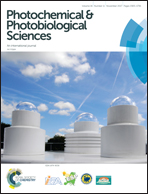Photodegradation of prednisolone under UVB solar irradiation. Role of photogenerated ROS in the degradation mechanism†
Abstract
The use of biologically active substances with anti-inflammatory properties such as corticosteroids has increased considerably in the last few decades. Particularly, the compound we are interested in, prednisolone (Predn), is a glucocorticoid with high biological activity. This compound absorbs UV radiation and may participate in photochemical processes, which can result in its own decomposition. These processes could result in the formation of free radicals or reactive oxygen species (ROS). On these grounds, the kinetic and mechanistic aspects of the direct photodegradation of Predn have been studied in aqueous medium under different atmospheric conditions by stationary and time-resolved techniques. The mechanism involved in the photodegradation has been elucidated. Predn is capable of generating the excited triplet state 3Predn* as a result of UVB light absorption. In the presence of oxygen, 3Predn* allows the formation of ROS, of which O2(1Δg) (ΦΔ = 0.014), H2O2 and the radical OH˙ stand out. The latter is generated from the spontaneous dismutation of O2˙− and subsequent homolytic cleavage, photochemically promoted, of H2O2. Predn undergoes unimolecular photodegradation reactions under an inert argon atmosphere. In this study we found that in the presence of oxygen, the Predn photo-consumption is improved. This implies that the attack by ROS involves a very important additional contribution to the photodegradation of Predn under aerobic conditions.



 Please wait while we load your content...
Please wait while we load your content...